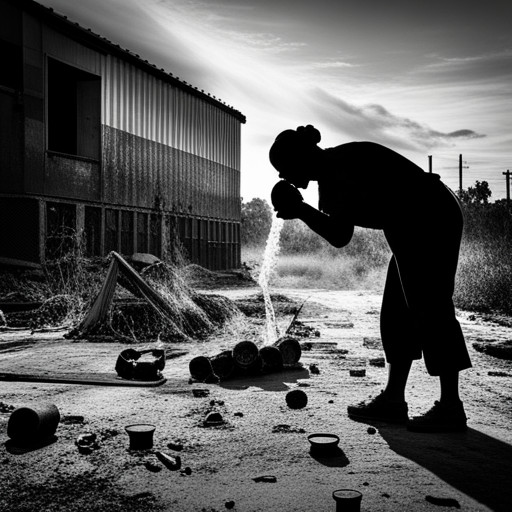Camp Lejeune Water Contamination Link to Microcephaly Lawsuit
The contamination of Camp Lejeune's water supply with volatile organic compounds (VOCs) from the 1950s to the 1980s has been linked to numerous health issues, notably birth defects such as microcephaly. Despite awareness of the contamination, action came late.

This article explores the history of this contamination, its health consequences, relevant scientific studies, and the subsequent legal proceedings, with a focus on the potential settlement values in microcephaly cases.
Key Takeaways
- The water supply at Camp Lejeune was contaminated with volatile organic compounds (VOCs) in the 1980s, including perchloroethylene (PCE) and trichloroethylene (TCE), at levels over 2000 times higher than EPA safety limits.
- Exposure to the contaminated water at Camp Lejeune has been linked to higher rates of birth defects, including microcephaly.
- Scientific studies have provided strong evidence of the association between exposure to Camp Lejeune water and birth defects, particularly neural tube defects and oral cleft defects.
- Victims of Camp Lejeune water contamination can now seek compensation through the Camp Lejeune Justice Act (CLJA), which establishes a reduced standard of proof for causation in claims and supports presumptive evidence of causation for neural tube birth defects.
The History of Water Contamination at Camp Lejeune

The contamination of the water supply at Camp Lejeune, which lasted from August 1953 to December 1987, resulted from volatile organic compounds (VOCs), including perchloroethylene (PCE) and trichloroethylene (TCE), being present at levels over 2000 times higher than EPA safety limits.
This extended exposure posed significant risks to health long term, with many individuals experiencing adverse effects. The government response was marked by a series of investigations and public health studies to assess the long-term impact of the contamination.
Despite the implications of these investigations, the remediation of the water supply was not immediate, resulting in prolonged exposure for many residents.
This historical event underscores the importance of prompt government response and strict regulatory measures in preventing health crises linked to environmental contamination.
Health Consequences of Water Contamination at Camp Lejeune

Exposure to volatile organic compounds (VOCs) in the drinking supply has been associated with increased rates of birth defects, particularly neural tube and oral cleft defects, among residents of military installations in the 1980s. Notably, Camp Lejeune experienced a significant contamination event that had far-reaching health effects.
The government response was multifaceted, involving extensive public health investigations and groundbreaking legislation to address the negative long-term health effects.
- A public health investigation revealed a correlation between exposure to this contaminated water and birth defects.
- Federal law now permits victims of the Camp Lejeune disaster to seek compensation.
- Research continues to unfold, illuminating the long-term health effects of VOC exposure, which include neural tube defects and a potential increased risk of microcephaly.
Understanding the Role of Volatile Organic Compounds (VOCs)

Volatile Organic Compounds (VOCs), such as perchloroethylene (PCE) and trichloroethylene (TCE), have been identified as potentially harmful substances that can cause a variety of adverse health effects. These compounds were detected in high concentrations in the water at Camp Lejeune, implicating them in the widespread health issues that surfaced among the camp's inhabitants.
| VOC | Health Impact |
|---|---|
| PCE | Negative impact on pregnancy outcomes |
| TCE | Associated with microcephaly in newborns |
The role of VOCs in the Camp Lejeune water crisis is critical, with these substances being linked to adverse pregnancy outcomes and instances of microcephaly. Hence, an understanding of the harmful effects of these compounds on human health is vital.
Government Actions and Scientific Studies in Response to the Contamination

Federal intervention and comprehensive scientific scrutiny served as principal responses to the health crisis caused by the presence of harmful substances in drinking supplies at Camp Lejeune. A public health investigation was also initiated by the federal government. The objective of the investigation was to assess the impact on the health of the population exposed to the contamination.
Scientific research was instrumental in establishing the link between exposure to the contaminated water and birth defects. Key outcomes from these studies include:
- Strong evidence of a correlation between exposure and adverse birth outcomes
- Identification of a significant risk increase for neural tube and oral cleft defects
- Affirmation from the VA Committee of the connection between exposure and neural tube birth defects
The Impact of Water Contamination on Pregnancy Outcomes

Preventive measures could have affected the prompt addressing of water contamination once discovered. However, the issue was not resolved until nearly three decades later, leading to the exposure of an estimated 1.1 million people to the toxins, with serious implications for pregnant women and their unborn children.
The Connection Between Water Contamination and Microcephaly

Scientific investigations have demonstrated a significant correlation between the ingestion of polluted liquids during gestation and the incidence of birth defects such as microcephaly. Studies conducted on the Camp Lejeune water contamination incidents have provided substantial evidence to support this correlation.
It is postulated that the volatile organic compounds (VOCs) present in the contaminated water were the contributing factors causing these birth defects.
The aftermath of the Camp Lejeune water contamination has led to numerous lawsuits, seeking compensation for the victims affected by this calamity.
Understanding Microcephaly: Causes, Symptoms, and Complications

Understanding the causes, symptoms, and complications of microcephaly necessitates a comprehensive exploration into the various factors that contribute to its occurrence, the signs that indicate its presence, and the potential health challenges that may arise as a result. This birth defect can be the result of several causes, such as genetic alterations, maternal infections, malnutrition, or exposure to harmful substances during pregnancy, including contaminated water.
| Causes of Microcephaly | Long-term effects of Microcephaly |
| Genetic alterations | Cognitive deficiencies |
| Maternal infections | Movement difficulties |
| Malnutrition | Hearing and vision problems |
| Exposure to harmful substances | Developmental delays |
Symptoms can range from mild to severe and may include a particularly smaller-than-average head size, a sloping forehead, and developmental delays. The long-term effects of microcephaly often entail lifelong medical treatment and care.
How Camp Lejeune Water Contamination Increases the Risk of Microcephaly

Exposure to volatile organic compounds (VOCs) in drinking water has been associated with an increased risk of birth defects, including microcephaly. This condition, characterized by a smaller-than-average head size, can lead to various long-term effects.
- Lifelong cognitive and developmental challenges
- Motor-function abnormalities, requiring continuous physical therapy
- Regular health monitoring due to associated conditions, including epilepsy.
Early intervention is of utmost importance for microcephaly, as it can significantly improve the child's development and quality of life. Comprehensive intervention strategies often include physical, occupational, and speech therapies.
The Camp Lejeune case underlines the critical need for clean, contaminant-free drinking water to prevent such severe health implications.
Government Recognition of the Link Between Contaminated Water and Birth Defects

In recent years, federal legislation has acknowledged the potential harm caused by polluted drinking resources, particularly in relation to congenital abnormalities. Pertinent to this is the case of Camp Lejeune, where the government's recognition of the disastrous effects of water contamination on newborns has resulted in legislative measures.
This recognition has led to the initiation of public health investigations, the results of which have established a clear correlation between the consumption of contaminated water and birth defects.
The legal implications of such recognition have also been noteworthy, culminating in the formation of the Camp Lejeune Justice Act, which permits victims to seek compensation.
Therefore, it can be concluded that the government's acknowledgment and legislative action have had profound effects on addressing this public health issue.
Compensation for Victims of Camp Lejeune Water Contamination

Legislative measures have been taken to allow victims of toxic exposure to seek financial compensation for the birth defects and health issues they have suffered. These initiatives are particularly pertinent to those affected by the Camp Lejeune water contamination incident.
The potential for government compensation is significant, with measures like the Camp Lejeune Justice Act that reduce the standard of proof for causation in these cases.
The settlement amounts are influenced by the severity and permanency of the birth defects.
These measures represent a crucial step towards justice for those affected, highlighting the government's recognition of the profound impact of such environmental disasters.
The Camp Lejeune Justice Act and Its Implications

Moving from discussions surrounding compensation for victims, attention is directed toward legislation enacted to aid those affected by the Camp Lejeune crisis.
The Camp Lejeune Justice Act (CLJA) represents a significant shift in the legal landscape. This Act, by establishing a reduced standard of proof for causation, opens the door for victims to seek redress.
The implications extend to the settlement payout range, which is influenced by factors such as the severity and permanency of the birth defect. This landmark legislation could potentially result in higher settlement values for birth defects with major long-term disabilities.
Previous settlements and verdicts in similar tort cases may provide guidance for estimating these settlement amounts as well.
Estimating Settlement Amounts for Camp Lejeune Birth Defect Claims

Estimating potential compensation figures for birth defect claims requires an intricate understanding of various factors, including the severity of the condition, its permanency, and precedents from similar cases. The Camp Lejeune Justice Act paves the way for victims to seek compensation. However, it also presents new legal challenges.
The compensation guidelines for these claims are still being fully established, but will likely consider:
- The extent and permanency of the birth defect
- The need for lifelong medical care or support
- The emotional distress and hardship endured by the victims and their families
These factors, coupled with the legal challenges posed by the nascent legislation, make the task of estimating potential compensation figures complex and multifaceted.
Legal Proceedings Related to Camp Lejeune Water Contamination

In relation to the legal proceedings concerning the polluted water supply, a law firm is currently seeking eligible plaintiffs who were exposed in utero to the contamination before 1988 and subsequently born with certain birth defects. Notably, the legal proceedings are aimed at addressing the health outcomes related to the Camp Lejeune water contamination crisis. Potential plaintiffs and their families are being informed about their compensation options.
This table summarizes the main elements of the ongoing legal processes and potential compensation routes.
| Eligibility Criterion | Legal Proceedings | Compensation Options |
| Exposed in utero before 1988 | File a lawsuit | Settlement |
| Born with certain birth defects | Join a class action | Compensation from the government |
| Medical documentation of the condition | Legal representation | Assistance programs |
| Residing at Camp Lejeune during the contamination period | Seek legal advice | Legal remedies |
Frequently Asked Questions
How Long Did It Take for the Government to Respond to the Water Contamination Issue at Camp Lejeune?
The government's response to the water contamination issue at Camp Lejeune was characterized by significant delays. Despite awareness of contamination as early as the 1950s, remedial actions were not undertaken until the late 1980s.
This lag in government accountability had profound health implications for those exposed. The ensuing public health investigation and subsequent legislation for victim compensation underscore the magnitude of the issue and the government's eventual recognition of its responsibility.
Are There Any Long-Term Health Effects on Adults Who Were Exposed to the Contaminated Water at Camp Lejeune?
Long-term health effects in adults exposed to the contaminated water at Camp Lejeune have been reported. Exposure symptoms may include various forms of cancer, liver disease, and neurological disorders, among others.
The contamination impact extends to serious health complications, potentially manifesting years after initial exposure. The severity of these effects is influenced by the duration and level of exposure to the harmful volatile organic compounds present in the water during the contamination period.
What Support Measures Are in Place for Those Affected by the Camp Lejeune Water Contamination?
Support measures for those affected by the Camp Lejeune water contamination include varios networks providing health and social assistance.
Additionally, recent legislative initiatives such as the Camp Lejeune Justice Act offer legal assistance, enabling victims to seek compensation for health issues linked to the contamination.
These measures facilitate the pursuit of justice and the provision of necessary care and support for those impacted by this environmental health disaster.
How Did the VOCs End Up Contaminating the Water Supply at Camp Lejeune?
Volatile organic compounds (VOCs), identified in the water supply of Camp Lejeune, originated from numerous sources, including industrial solvents and dry-cleaning chemicals. Inadequate containment and disposal practices led to the seepage of these VOCs into groundwater.
Despite awareness of potential contamination, preventative measures were not undertaken promptly, resulting in prolonged exposure to VOCs for residents. Therefore, the contamination was primarily due to a combination of unsuitable disposal practices and inefficient prevention measures.
Are There Any Other Military Bases That Have Experienced Similar Water Contamination Issues?
Indeed, numerous military bases have experienced similar water contamination issues.
A comparative analysis reveals that bases such as Fort Detrick, Maryland, and the former George Air Force Base, California, reported significant contamination.
Contamination prevention has been a challenge, with contaminants including volatile organic compounds, heavy metals, and per- and poly-fluoroalkyl substances.
Comprehensive environmental assessments, vigilant monitoring, and stringent regulation enforcement are necessary for effective contamination prevention across military bases.




